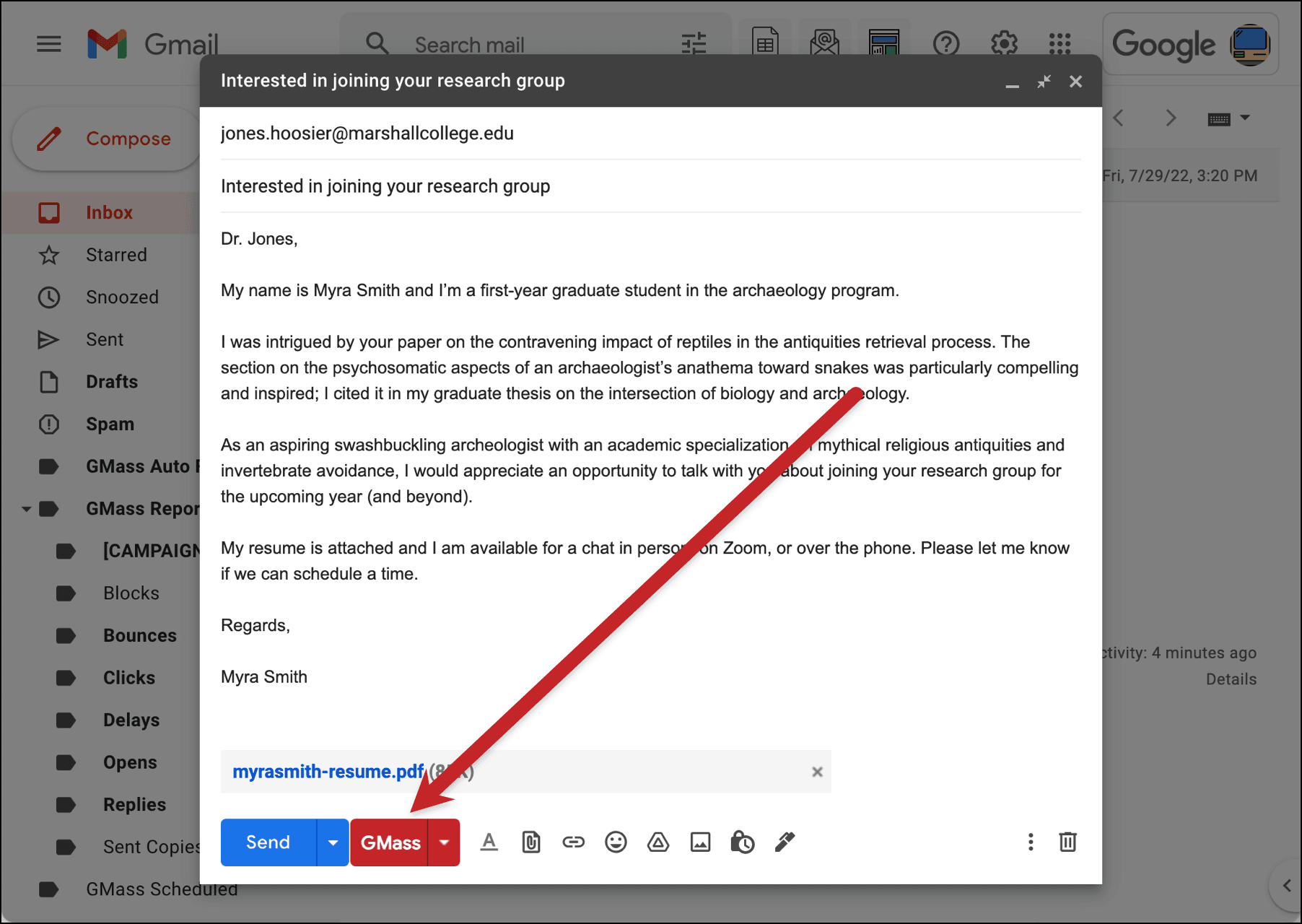Replying to a professor’s email can feel daunting. You want to make a good impression.
When you’ve sent a cold email to a professor and received a response, the next step is crucial. A well-crafted reply can open doors to opportunities and build a solid academic relationship. It’s important to be polite, clear, and concise in your communication. A thoughtful response demonstrates your genuine interest and respect for their time, which may lead to further engagements or collaborations. Research has shown that personalizing your reply can significantly improve good reply rates for cold emails. Therefore, make sure to address any specific points they’ve mentioned and express your eagerness to discuss potential projects or research interests.
This blog will guide you on how to craft a professional and effective reply to a professor’s email. Whether you’re seeking advice, research opportunities, or just trying to connect, these tips will help you respond appropriately. Let’s dive in and make sure your reply leaves a positive impact.
Crafting A Polite Opening
Crafting a polite opening is crucial when replying to a professor’s reply to your cold email. A thoughtful and respectful response sets the tone for effective communication. Here are some steps to ensure your reply is well-received.
Acknowledge The Response
Begin by acknowledging the professor’s response. This shows you appreciate their time and effort.
- Use phrases like “Thank you for your response.”
- State that you received their email.
- Mention any specific points they addressed.
For example:
Dear Professor [Last Name],
Thank you for your response. I appreciate you taking the time to answer my query about [specific topic].Express Gratitude
Expressing gratitude is essential. This shows respect and builds rapport.
- Thank them for considering your request.
- Show appreciation for their guidance.
- Acknowledge any advice or information they provided.
For instance:
I am grateful for the information you provided on [specific topic]. Your guidance is invaluable, and I look forward to learning more.By acknowledging the response and expressing gratitude, you create a positive and respectful tone in your email. This approach helps build a good relationship with the professor, making future communications more effective.

Credit: vacancyedu.com
Addressing The Professor’s Points
Addressing the professor’s points in their reply can be a daunting task. It’s important to acknowledge their comments and respond thoughtfully. This shows you value their time and are eager to engage. Here’s how to effectively address the key points.
Summarize Key Points
Start by summarizing the professor’s main points. This shows you understand their response. For example, “Thank you for your reply. You mentioned that…”
Listing the key points helps structure your response. It also ensures you cover all important aspects. Be concise and stick to the main ideas.
Respond Clearly
Respond to each point clearly. Address each comment with a direct response. For example, “Regarding your suggestion about…”
Be polite and professional. If you have questions, ask them directly. “Could you please clarify…” shows you are engaged and interested.
End with a courteous note. Thank the professor for their time and assistance.
Providing Additional Information
Reply to the professor’s email by thanking them for their response. Clearly provide any additional information requested. Ensure your message is concise and polite.
Providing additional information in your reply can make your communication with the professor clearer. It shows you are prepared and serious about the conversation. Here are some steps to make your response more effective.Attach Relevant Documents
Include any documents that support your query. This could be a resume, a research proposal, or previous work samples. Ensure the files are named properly. This makes it easier for the professor to understand the context.Offer Further Details
Provide specific information related to your request. If you are asking about a research opportunity, mention why you are interested. Share how your skills align with their work. This helps the professor see your dedication and interest.Clarifying Your Intent
Express gratitude and clarify your intent in your reply to the professor’s cold email response. Be concise and direct, ensuring your questions or requests are clear and respectful.
In your cold email to a professor, you took the first step. The professor’s reply means you’re on the right path. But now, you must clarify your intent. This ensures the conversation stays productive and clear. Let’s break down how to do this effectively.Restate Your Purpose
Begin by restating why you reached out. It helps to remind the professor of your initial goal. For example, if you asked about research opportunities, mention that again. This shows you are focused and consistent.Explain Your Request
Next, clearly explain what you need from the professor. If you need more details about a project, ask specific questions. If you need advice on your application, state that. Being direct and clear will help the professor understand your needs.Maintaining A Professional Tone
Replying to a professor’s email requires a professional tone. This is important for maintaining respect and clarity. Here are tips for keeping your response professional:
Use Formal Language
When replying, always use formal language. This shows respect and seriousness. Avoid casual words that you might use with friends. Here is a table of formal vs. informal phrases:
| Formal | Informal |
|---|---|
| Dear Professor | Hey Prof |
| Thank you for your response | Thanks for getting back |
| I look forward to your feedback | Can’t wait to hear back |
Avoid Slang
Slang can make your email seem unprofessional. Always use proper grammar and complete sentences. Some common slang to avoid includes:
- Wanna (use “want to”)
- Gonna (use “going to”)
- LOL (use “laugh out loud” if necessary)
Following these tips will help you maintain a professional tone. This is key when communicating with professors.
Timing Your Response
Responding to a professor’s reply promptly is crucial. It shows respect and keenness. Timing is everything. A well-timed response can make a great impression.
Respond Promptly
Always reply as soon as possible. A quick response shows that you are serious. It also keeps the conversation fresh. Here are some tips:
- Reply within 24 hours.
- If you need time to gather information, acknowledge the email first.
- Use a clear subject line if the conversation shifts focus.
Consider Time Zones
Professors may be in different time zones. Respect their working hours. This ensures your email reaches them at a convenient time.
Here is a table to help you:
| Region | Time Zone | Working Hours |
|---|---|---|
| USA (East Coast) | EST | 9 AM – 5 PM |
| USA (West Coast) | PST | 9 AM – 5 PM |
| Europe | CET | 9 AM – 5 PM |
| Asia | IST | 9 AM – 5 PM |
Use online tools to convert time zones. This helps in sending your email during their work hours. A well-timed email can lead to a faster response.
Proofreading Before Sending
Replying to a professor’s email can be a nerve-wracking task. To make a good impression, your response should be clear and error-free. Proofreading before sending ensures that your message is professional and respectful. Here, we discuss two key aspects of proofreading: checking for errors and ensuring clarity.
Check For Errors
Before hitting send, scan your email for any spelling or grammatical mistakes. These errors can make you look unprofessional. Use tools like Grammarly or Hemingway to identify and correct them. Pay attention to:
- Spelling: Double-check for typos or misspelled words.
- Grammar: Ensure your sentences follow proper structure.
- Punctuation: Use commas, periods, and other punctuation marks correctly.
Even a small mistake can change the meaning of your message. Take the time to read your email aloud. This helps you catch errors you might miss otherwise.
Ensure Clarity
Your email should be easy to read and understand. Avoid using complex words or jargon. Break long sentences into shorter ones. Ensure each paragraph covers a single idea. This makes your message clear and concise. Consider the following tips:
- Simple Language: Use common words that are easy to understand.
- Short Sentences: Keep sentences under 12 words if possible.
- Single Idea Paragraphs: Each paragraph should focus on one topic.
Proofreading is not just about finding errors. It is also about making sure your message is clear. A well-written email shows respect for the professor’s time and attention.

Credit: www.linkedin.com
Closing The Email
Replying to a professor’s email can be daunting. Start by thanking them for their response. Address any questions they asked and provide clear, concise information.
Closing an email to a professor is crucial. It shows respect and professionalism. Your closing sets the tone for future communication. Make sure it leaves a positive impression.End With Politeness
Express gratitude for their time. A simple “Thank you for your response” works well. It’s polite and shows appreciation. Avoid casual phrases. Use respectful language. Close with “Best regards” or “Sincerely.” These phrases are formal and appropriate.Include Contact Information
Provide your contact details. Include your full name. Add your phone number and email address. This makes it easy for the professor to reach you. Ensure your contact information is accurate. Double-check for any typos. This shows attention to detail.
Credit: www.youtube.com
Frequently Asked Questions
How To Address A Professor’s Reply?
Address the professor respectfully using their title and last name. Be polite and professional in your response.
Should I Reply Immediately To A Professor’s Email?
Yes, reply promptly to show your interest and respect. It leaves a good impression.
What To Include In The Reply Email?
Include a thank you note, address any questions, and provide requested information. Be concise.
How To Express Gratitude In The Reply?
Start your email by thanking the professor for their response. Show appreciation for their time.
Conclusion
Replying to a professor’s email can seem challenging. Stay respectful and concise. Show gratitude for their time. Answer any questions they posed. Clarify your points if needed. Keep your response professional and polite. Proofread your email before sending. This ensures clarity and correctness.
Build a positive rapport through your response. Good communication strengthens academic relationships.
